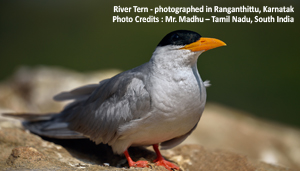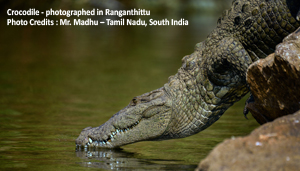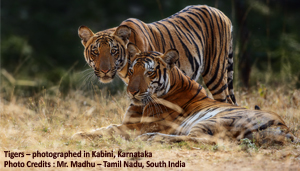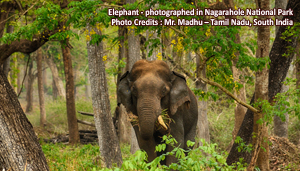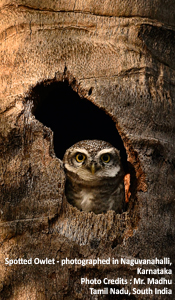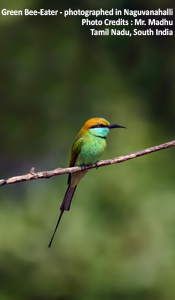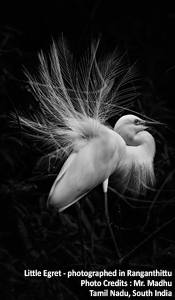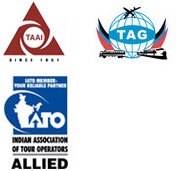Cultural and Birding Photo Tour, South India |
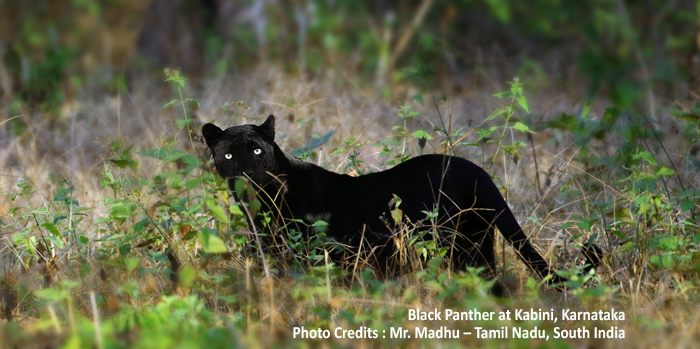 |
Itinerary |
Day 01 – ARRIVE BANGALORE Transfer to your Hotel, The Taj Bangalore, Nr. Kampegowda Intl. Airport, Devanahalli (Hotel is at walkable distance of 05 min. from the Intl. Arrival. You can also bring along the Airport luggage trolley upto the hotel) Day 02 – BANGALORE - VIJAYNAGAR (BELLARY) AIRPORT - HAMPI (By Flight) Breakfast at your Hotel. Today, at leisure in the Morning. Latter in the afternoon take domestic flight by True jet from Bangalore to Jindal Vijaynagar Airport, Bellary. Meet our Driver/Representative and as time permits, transfer to Daroji Sloth Bear Sanctuary and near about birding sights and then proceed to your hotel HAMPI HERITAGE for overnight and Dinner. (Your Naturalist, will be assisting you in your program of 04 nights) Day 03 – HAMPI Hampi better known as the world’s largest open air museum, after all these centuries testifies to the glory of the Vijayanagara Empire. The still-standing monuments, with their carefully articulated design and sculpture, pay tribute to the opulence and grandeur. The iconic Stone Chariot and the legendary musical pillars within the Vijaya Vittala Temple: which, as the legend goes, was built for Lord Vishnu himself and the ancient Virupaksha Temple which is believed to have hosted the betrothal of Lord Shiva and Parvati; and countless other monuments steeped in history. Today, proceed for morning session of Birding around Hampi Area. Latter, have Breakfast and start your day with Hampi sightseeing including the Virupaksha Temple, Hemakuta Hill, Monolithic Lakhsmi Narasimha, Krishna Temple, Badavilinga and Hampi Bazaar. HAMPI HERITAGE for overnight and Dinner. (Please note that at some of the places, Driver will use his TATA ZEST Petrol Car with AC for Birding as Innova people will not agree to make off road driving) Day 04 – HAMPI – HOSEPET (aprox. 15kms/30min) – BADAMI (aprox. 130kms/03hrs) AM – Hide Photography – Birding in the Field – Breakfast and Latter proceed to visit the Badami cave temples and are definitely worth a visit. They form part of the Hampi – Badami – Pattadakkal – Aihole old temple and monument circuit in North Karnataka, between Bagalkot and Hospet. They may be in an old and ruined condition, but simply cannot be ignored because of the beauty and mastery of architects and sculptors who built them in a bygone era. The Badami caves date back to between the 6th to 8th centuries when they were carved out of the almond (badami) coloured sandstone cliffs. They are among the oldest Hindu cave temples in India. There are four main caves close to each other. Cave 1 is dedicated to Lord Shiva. Cave 2 is similar in structure to Cave 1, but dedicated to Lord Vishnu, with a lot of carvings and reliefs of Lord Brahma, Vishnu, Vamana, Varaha, Durga and Kartikeya. Cave 3 is dedicated to both Shiva and Vishnu and has giant carvings of Trivikarma, Anantasayana, Vasudeva, Varaha, Narasimha and Harihara. The Harihara carving shows half Shiva and half Vishnu fused into one. Cave 4 is dedicated to the Jain Tirthanakaras and has carvings of Lord Mahavira, Bahubali and Parshvanathas and some other Tirthankaras. As time permits, you will go to Gadag – Magadi Lake to see Bar Headed Goose. Latter in the evening, transfer to your Hotel the Heritage Resort, Badami for overnight and Dinner. Day 05 – BADAMI – GANESHGUDI WITH STAY AT OMH JUNGLE LODGES & RESORT (APROX.170KMS/04HRS) AM – Birding in the field. Breakfast and proceed for balance tour of Badami Heritage sites and latter proceed to Ganeshgudi with session in OMH Studio photography and Evening Bridge Side for Hornbill photography. Dinner and Stay at OMH Cottage, Ganeshgudi. Day 06 – GANESHGUDI – HUBBALI AIRPORT (aprox.80kms/02hrs) – BANGALORE – BY FLIGHT Early Morning Session photography in OMH Breakfast & Check out from OMH and Birding in Timber Yard Dandeli. Latter, proceed in time to reach Hubbali Airport for your Evening flight to Bangalore by Air India. On arrival in Bangalore, meet our Driver/Representative and transfer to your Hotel Court Yard by Marriott, Hebbal, Bangalore for overnight. Day 07 – BANGALORE – RAMDEVRABETTA VULTURE SANCTUARY (Aprox. 70 kms/02 hrs) – BANGALORE S/SEEING AND SHRAVANABELAGOLA (Aprox. 150 kms/03 hrs) – HASSAN (Aprox. 60kms/01 hrs) With packed Breakfast, Temple proceed for Ramdevrabetta Vulture Sanctuary, which is situated in the Ramanagara district. The hill gets its name from the temple dedicated to Lord Rama which is situated atop this hill. The scrub patch around Ramadevara Betta at Ramanagara along the Mysore Road, which houses the critically-endangered Long-billed vulture (Gyps indicus).The State forest department has created a vulture sanctuary and the entire scrub patch of 856 acres around the hillock which consists of the boulder with aprox. Thirteen Long-billed vultures is accorded a protected status. The hill Ramadevara betta, along with Savandurga was one of the shooting locations for David Leans A Passage to India. Small door like grottoes were made in the rock to resemble caves. It was also in this region that the path-breaking Hindi movie, Sholay, was shot. (Below are the pointers mentioned by the Naturalist – “ Ramdevarabetta is a small rocky hill with a temple at the top and there is a short trek uphill of around 350 steps. Vulture nests will be on the cliffs of the rocky hill. Its unlikely we will be able to make it to the nest & photographing opportunities will be only with vultures hovering in air and generally sighting chances are higher during early hours in the morning. I have friends with whom we can confirm the status of birds, on the previous day before our departure. Alternatively, there is a place called Hesarghatta. Its basically a manmade lake and has decent opportunities to photograph birds, especially in the winter months.”) In latter part of the day, proceed back to Bangalore to take panoramic tour of Bangalore city visiting Tipu Sultans Palace Museum, pass by Bangalore Palace and have a look at Vidhan Sagha (Legislative Assembly, High Court and at the end see Bull Temple. From Bangalore, proceed to the holy Tirthas of Shravanabelagola, nestled by the Vindhyagiri and Chandragiri Hills, protected by the monolith Bhagwan Bahubali, and home to over 2,300 years of Jain heritage, is a veritable picture postcard of our history and heritage spanning the centuries. In the town of Shravanabelagola, stands a colossal rock-cut statue of Lord Gommateshwara Shri Bahubali. About eight hundred odd inscriptions which the Karnataka Archeological Department has collected at the place are mostly Jaina and cover a very extended period from 600 to 1830 A.D. Some refer even to the remote time of Chandragupta Maurya and also relate the story of the first settlement of Jains at Shravanabelagola. The Gommateshwara Bahubali statue at Shravanabelagola is one of the most importanttirtha (pilgrimage destinations) in Jainism, one that reached a peak in architectural and sculptural activity under the patronage of Western Ganga dynasty of Talakad. Chandragupta Maurya is said to have died here in 298 BCE after he became a Jain monk and assumed an ascetic life style. The 58-feet tall monolithic statue of Gommateshwara is located on Vindyagiri Hill. It is considered to be the worlds largest monolithic statue. The base of the statue has an inscriptions in Prakrit i.e.Devnagari script, dating from 981 AD. Every twelve years, thousands of devotees congregate here to perform the Mahamastakabhisheka, a spectacular ceremony in which the statue is anointed with Water, Turmeric, Rice flour, Sugar cane juice, Sandalwood paste, saffron, and gold and silver flowers. SPECIAL NOTE – The Gommateshwara Bahubali Statute at Shravanabelagola is open from Morning, 0700am to 1130am and again at 0330pm to 630pm only, so plan your trip accordingly After visiting Shravanabelagola, proceed to Hassan Town. Dinner and overnight at Hoysala Village Resort, Hassan Day 08 – HASSAN – HALEBIDU (Aprox. 30 kms/45 min) – BELUR (Aprox. 17kms/30 min) – HASSAN Today, after Breakfast, proceed to visit Halebidu (which used to be called Dorasamudra or Dwarasamudra) was the regal capital of the Hoysala Empirein the 12th century. It is home to some of the best examples of Hoysala architecture. Most notable are the ornate Hoysaleshwara and Kedareshwara temples. The city got the name "Halebidu" because it was damaged and deserted into "old capital" after being ransacked and looted twice by Islamic forces of the Delhi Sultanate in the 14th-century. The town is known for its temple complexes Hinduism - Hoysaleshwara temple and Kedareshwara temple Jainism - Parshvanatha BasadiandShantinatha Basadi After visiting Halebeedu, proceed to visit Belur which is home to a Vishnu-related Hoysala Hindu temple complex from the 12th century called the Kesava Temple at Belur. This temple along with Hoysaleshwara Temple and Jain temples in Halebidu have been proposed as UNESCO world heritage sites. The town is renowned for its Chennakeshava Temple, one of the finest examples of Hoysala workmanship. Belur was the early capital of the Hoysala Empire. According to inscriptions discovered here, it was also referred to as Velur or Velapuri. It was the early capital of the Hoysala kings in 11th-century and remained a second capital through the 14th-century. The city was so esteemed by the Hoysalas that it is referred to as "earthly Vaikuntha" (Vishnus abode) and "dakshina Varanasi" (southern holy city of Hindus) in later inscriptions.So many workers worked for building Belur. It took 190 years to complete. Latter, return back to Hassan for dinner and overnight at your hotel Hoysala Village Resort, Hassan. Day 09 – HASSAN – RANGANATHITTU BIRD SANCTURAY (Aprox. 120 kms/2.30 hrs) – SRIRANGAPATNA - MYSORE (Aprox.80kms/1.45 hrs) Today, Early in the morning, armed with packed Breakfast, proceed for Ranganathittu Bird Sancturary whichis lying beautifully on the banks of River Cauvery, this sanctuary is the home to some of the most exquisite birds. Named after the Hindu God Sri Ranganatha Swamy, who is an incarnation of Lord Vishnu, this bird sanctuary is spread across an area of 40 acres. In 1600s, a small dam across the Cauvery River led to the formation of Ranganathittu. It was because of world renowned ornithologist Doctor Salim Ali determination and ability to convince the then Mysore maharaja that Ranganathittu was declared as a protected area. He while surveying the area noticed a wide variety of birds here and hence laid highlighted the importance of declaring this area as a bird sanctuary. Comprising six small islands, this place was declared as a bird sanctuary in the year of 1940. Roughly 170 bird species have been recorded here. Of these, the painted stork, Asian openbill stork, common spoonbill, woolly-necked stork, black-headed ibis, lesser whistling duck, Indian shag, stork-billed kingfisher, egret, cormorant, Oriental darter, spot-billed pelican and heron breed here regularly. The great stone plover, and river tern also nest here. The park is home to a large flock of streak-throated swallows. During the months of January and February, more than 30 species of birds are found and the season of the sanctuary is from November to June. About 50 pelicans have made Ranganathittu as their permanent home. During winter months, starting from mid-December, as many as 40,000 birds congregate in this bird sanctuary. Of which, some birds come from Siberia, Latin America and parts of north India.Ranganathittu is a popular nesting site for the birds. Fauna - The islands are host to numerous small mammals, including bonnet macaque, colonies of flying fox and common small mammals like common palm civet and Indian gray mongoose and the monitor lizard. The mugger crocodile or marsh crocodile is a common inhabitant of the riverine reed beds and Ranganathittu has largest fresh water crocodile population in Karnataka state. Ranger-guided boat tours of the isles are available throughout the day, and are a good way to watch birds, crocodiles, otters and bats. The Salim Ali Interpretation Centre, maintained by Forest Department, screens a 4- minute documentary to special interest groups. Latter, proceed to visit historical town of Srirangapatna The town is famous for a very ancient temple dedicated to Sri Ranganathaswamy, a form of Lord Vishnu along with other temples. Srirangapatna also hosts the summer palace of Tipu Sultan and his mausoleum. Daria Daulat Bagh - The Dariya Daulat Palace (Summer Palace) is set amidst beautiful gardens called Daria Daulat Bagh. Tippu Sultan built this palace in 1784. The palace is built in the Indo-Sarcenic style in mostly made of teakwood. The palace has a rectangular plan and is built on a raised platform. Other attractions in Srirangapatna include the Jumma Masjid (a Mosque) and the Daria Daulat Gardens. The mosque has stone Arabic inscriptions which mention the 99 different titles given to the Prophet Mohammed, along with the Farsi inscriptions which mentions that the Jamia Masjid called Masjid-E-Ala was built in AD 1782 by Tipu Sultan. Tipu Sultan Gumbaz- The Gumbaz is an impeccably detailed mausoleum and houses the remains of Tipu Sultan, his father Hyder Ali and his mother Fatima Begum among beautifully manicured gardens. Various tombs of other relatives surround the gumbaz, some with small signs offering guidance on which specific individuals are buried here. The outer gumbaz columns are made of amphibolite, a very dark rock that exudes a somber richness. Handcrafted door frames covered in a deep lacquer finish lead into an inner tomb illuminated only by natural light. All visitors are welcome inside, and even encouraged to enter by the friendly doormen. Srirangapatna Fort - The fortress is situated in the west of the island, and is surrounded by double walls. The point at which the British broke through the walls, and thus Tipu Sultans troops surprised, is marked by an obelisk. Also highlighted is the place where Tipu Sultan was killed by the British forces. In addition, the dungeon in which the Mysore rulers had imprisoned British soldiers. Latter, proceed to Mysore. You dinner is organized at outside Restaurant and overnight stay at Lalitha Mahal Palace Hotel. Day 10 – MYSORE - NAGUVANHALLI - KOKKARE BELLUR BIRD SANCTUARY – MYSORE (Aprox.80kms/1.45 hrs, Oneway) Today, proceed for Naghuvanalli and another Bird Sanctuary – Kokkarebellur, It is a village in Maddurtaluk of Mandya district of Karnataka, India. The village is named after the painted stork(Ibis leucocephalus) called “kokkare” in Kannada language. Apart from painted storks the spotbilled pelicans, are also found here. Both are classified as “near threatened category” in IUCN Red List of 2009. The village is one of the 21 breeding sites existing in India. The uniqueness in Kokkarebellur is the long established bonding between the spot-billed pelicans and the villagers who have adopted this bird as their heritage, since they consider the birds as harbingers of good luck and prosperity to the village. The benefits derived by the villagers from these birds are basically in the form of phosphorus and potassium rich manure obtained from the bird droppings (also known as quano). Apart from the pelicans, the other birds found nestling and breeding in the village trees are the painted stork (Ibis leucocephalus), little cormorant (Phalacrocorax niger), black ibis (Pseudibis papillosa), grey heron (Ardea cinerea), black-crowned night heron (Nycticorax nycticorax) and Indian pond heron (Ardeola grayii). Birds are seen nesting in clusters of 15 to 20 pairs per tree and are thought to use the same tree each year. They arrive after monsoon rains ends in September when the birds create their nests, lay eggs from October to November, thereafter fledge around for three months after laying of eggs, till March and tirelessly feed their hatchlings through the summer season. As summer peaks in May, they re-migrate, year after year, except when they sense drought conditions in their colonial habitat. Village women turning sentimental about the birds returning to their homeland say: For us, these birds are like a daughter coming home for delivery.... (Below are the pointers mentioned by the Naturalist – Guess, you have already conveyed them the point that Kokkare Belluru will hold the same species of birds that they will be seeing in Ranganthittu. Please make sure they are informed as we do not want them to get disappointed after reaching there). Latter, proceed back to Mysore. In latter part of the day, proceed for Mysore City sightseeing. Mysore is a major tourist destination in its own right and serves as a base for other tourist attractions in the vicinity. One of the most visited monuments in India, the Amba Vilas Palace, or Mysore Palace, is the centre of the Dasarafestival. The Jaganmohana Palace, The Sand Sculpture Museum, the Jayalakshmi Vilas and the Lalitha Mahal are other palaces in the city. Chamundeshwari Temple, atop the Chamundi Hills, and St. Philomenas Church, Wesleys Cathedral are notable religious places in Mysore. The Mysore Zoo, established in 1892, the Karanji, Kukkarahalli and the Blue Lagoon Lake are popular recreational destinations. Blue Lagoon which is a lake with a mini island is located behind KRS water Dam and it is very mesmerizing to be there and watch the sunset and sunrise. The colour of the water and the sky is Blue and there is a mini island in the middle due to which it was named as Blue Lagoon. Mysuru has the Regional Museum of Natural History, the Folk Lore Museum, the Railway Museum and the Oriental Research Institute. The city is a center for yoga-related health tourism that attracts domestic and foreign visitors, particularly those who, for years, came to study with the late ashtanga yoga guru K. Pattabhi Jois. A short distance from Mysuru city is the neighboring Mandya Districts Krishnarajasagar Dam and the adjoining Brindavan Gardens, where a musical fountain show is held every evening. Dinner is organized at outside Restaurant and overnight stay at Lalitha Mahal Palace Hotel. Day 11 & 12 – MYSORE – KABINI ( Aprox. 80kms/02hrs) After Breakfast at your hotel, proceed for Kabini. The Kabini Forest Reserve is one of the most popular wildlife destinations of Karnataka, probably because of its accessibility, lush green landscape surrounding a large lake, and sightings of herds of elephants, tigers. It comprises the south-eastern part of Nagarahole National Park. Situated on the banks of the Kabini River, the reserve is spread over 55 acres (22 ha) of forestland, steep valleys, and water bodies. Once a private hunting lodge of the Maharaja of Mysore, Kabini was a popular shikarhotspot for British Viceroys and Indian royalty. Now it is considered to be one of the best Wildlife National Parks in India, famous for its spectacular wildlife and bird life. There are around 120 tigers, 100+ leopards, Four types of deer, Sloth bear, Indian Gaurs and elephants in the Nagarahole National Park. You will be staying of 02 nights River Kabini River Lodge on a All Inclusive Package - Named after the River Kabini, the Lodge beckons with the promise of elephants, gaur, deer and a rumor of tiger. Located on the southern fringes of the Nagarahole National Park (Rajiv Gandhi National Park) , this former hunting lodge of the erstwhile Maharaja of Mysore was rated as One of the Top 5 Wildlife Resorts in the World by the British Tatler’s Travel Guide. A sprawling colonial estate in the heart of elephant country, the River Kabini Lodge echoes with the call of the wild. PLEASE VIEW YOUR KABINI NP ITINERARY IN KABINI BY CLICKING THE BELOW LINK http://www.junglelodges.com/kabini-river-lodge-itinerary/ ( Your Naturalist will be assisting you in your program of 02 nights) Day 13 & 14 – KABINI – THIRUNELLY, WAYANAD, KERALA ( Aprox. 50kms/02hrs) After Breakfast at your hotel, proceed for Thirunelly, Wayanad, Kerala. Your Stay for 02 Nights will be at Jungle Retreat, Wayanad which is a 10 acre farm surrounded by jungle on all sides and you can have daily wildlife sightings right inside the farm itself. It is an ideal escape for wildlife and nature lovers, you can see animals from your room’s balcony as they graze in the meadows or come for a drink in the watering-hole inside the farm and host of activities awaits you such as all-day jungle treks and wildlife safari drives in Wayanad and Nagarahole. (Your Naturalist will be assisting you in your program of 02 nights) Day 15 & 16 – THIRUNELLY, WAYANAD – BANDIPURA - MUDUMALAI NATIONAL PARK / MASINAGUDI (Aprox. 140 kms / 04 HRS) Today, after breakfast, proceed for Bandipura and then on to Mudumalai National Park / Masinagudi. The Mudumalai National Park and Wildlife Sanctuary also a declared tiger reserve, lies on the northwestern side of the Nilgiri Hills (Blue Mountains). The protected area is home to several endangered and vulnerable species including Indian elephant, Bengal tiger, gaur and Indian leopard. There are at least 266 species of birds in the sanctuary, including critically endangered Indian white-rumped vulture and long-billed vulture. Eight percent of bird species in India occur in the Mudumalai Wildlife Sanctuary. Among the 266 bird species found in Mudumalai, 110 species are insectivores, 62 are carnivores, 23 species are fishivores, 12 species are omnivores and 20 species are granivores. These include the unique near threatened black-and-orange flycatcher. Regional endemics include Malabar trogon and Malabar grey hornbill. Some rare birds of prey like the rufous-bellied eagle can occasionally be seen in this sanctuary. Other predatory birds include crested hawk-eagle, crested serpent eagle, changeable hawk eagle, black eagle, Oriental honey-buzzard, Jerdons baza, Bonellis eagle, crested goshawk, besra, mottled wood owl and brown hawk owl, and several minivets. There are also hornbill, golden oriole, chloropsis, paradise flycatcher, golden-backed woodpecker Malabar great black woodpecker, blue-winged parakeet, fairy bluebird, jungle fowl racket-tailed drongo, peafowl, red spurfowl, grey francolin, painted spurfowl, painted bush quail, white-bellied woodpecker, lesser yellownape, golden woodpecker, streak-throated woodpecker, chestnut-headed bee-eater, emerald dove, green imperial pigeon, grey-fronted green pigeon, grey-bellied cuckoo, Indian cuckoo, alpine swift, black-hooded oriole, greater racket-tailed drongo, black-headed cuckooshrike, grey-headed bulbul, forest wagtail, crimson-backed sunbird and Lotens sunbird. It also holds the isolated southern population of the striped tit-babbler. Dinner and overnight at your Lodge Jungle Hut, Masinagudi for 02 nights Your Naturalist will be conducting your Photo Tour in exclusive Jeep starting from Morning and on the other day, upto Lunch time on next day. This will include a nocturnal session of Flash Photography, depending on Guests intrest. Nocturnal Session is when we will get shots of Owls, Night Jars, Frogmouths and other Nocturnal Birds, Exotic Colorful Frogs and other Herpi Fauna. Day 17 & 18 – MASINAGUDI – UDHAGAMANDALAM (OOTY) – COONOOR (Aprox. 60 kms / 1.30 hrs) This morning, after breakfast, transfer towards the Blue Mountains near Udhagamandalam, among the highest mountains in all of Southern India. The scenery is superb within a garden-like setting of rhododendron and magnolia forests draped with an assortment of orchids. The small hill station here was once a very popular, charming and thriving location during the time of British occupation. The town has certainly changed quite a bit since these times, yet the odd grand building and luxurious hotel still remains and provides some insight into what it may once have looked like. The higher elevations of the Western Ghats are dotted with patches of moist evergreen forest, locally known as sholas, and it is these forests that hold many of the region’s most desirable endemics. We will spend the day soaking in our surroundings while looking for geographically restricted species. You also have option of experiencing Niligiri Mountain Railway from Ooty to Coonoor or Vice versa. You will be staying for 02 Nights in Ooty / Coonoor in Club Mahindra - Derby Green. (Below are the pointers mentioned by the Naturalist – Please inform them that I have a friend who has Bird Hide in Kothagiri (in the ooty area) with good bird photographing opportunities. If you require we can take you there, as well and can be done in the evening session before going to Conoor on Day 17. Day 19 & 20 – COONOOR - POLLACHI (Aprox. 150 kms / 4 hrs) To-day, in the morning proceed for Pollachi for 02 nights Stay at Great Mount Coco Lagoon Resort with Dinner. Anamalai Wildlife Sanctuary is situated at an average altitude of 1,400 feet (430 m) in the Western Ghatsnear Pollachi. Valparai is a hill station about 65 kilometres (40 mi) from Pollachi and is situated at an altitude of 3,500 feet (1,100 m) Valparai Range of Anamalais is situated at an altitude of 3500 feet above the sea level. Interspersed by lush green rainforests and tea plantations, the region is a rich bird watching tract. Our birding area is nestled away from the crowded tourist zones and is amidst the undulating tea slopes of private plantations, tall blue mountains and forest patches, providing the perfect getaway, you’ve always dreamt of as bird- watcher. Flagship Species you can expect to sight: Great Pied hornbill, Scimitar Babbler, Rufous Babbler, Malabar Grey Hornbill, Kerala Laughing Thrush, Malabar Whistling Thrush, Yellow browed bulbul, Oriental white eye, Velvet fronted Nuthatch, Long tailed shrike, Black bulbul, Hill Mynahs etc., Other Birding area is Sethumadai.It is a world of lush green coconut farms, shrub jungle, mountains, trails and canals, just adjacent to Anamalai Tiger Reserve – A paradise for bird watching! Flagship Species you can expect to sight: Blue-faced Malkoha, Sirkheer Malkoha, Emerald Dove, Tickell’s Blue Fly- catcher, Blue-bearded Bee Eater, Vernal Hanging Parakeet, Brown Fish Owl, Flame Throated Bulbul, Stork-billed Kingfisher, Brown Headed Barbet Winter – Migrants: Grey Wagtail, Asian Brown Fly-catcher, Indian Paradise Fly-catcher, Golden Oriole, Blue Throated Blue Flycatcher, Indian Blue Robin. Day 21 – POLLACHI - PARAMBIKULAM TIGER RESERVE (Aprox. 50 kms / 2 hrs) After early Breakfast, Proceed for Parambikulam for 01 nights Wildlife and Birding at Parambikulam Tiger Reserve. Your stay in the Reserve will be in Swiss Tents at Tended Niche Camp site managed by the Forest Department and is basic and inclusive of all Meals and Activities as per Itinerary The sanctuary has a rich diversity of animal life including: Mammals 39 species, Birds 268 species amongst others. This sanctuary is also referred to as the "state capital for the massive gaur" by wildlife experts. · Mammals Important mammals include: lion-tailed macaques, Nilgiri Tahr, Elephants, Bengal Tigers, Indian Leopards, Wild Boar, sambar, Bonnet Macaques, Nilgiri Langurs, Sloth Bears, Nilgiri Marten, Small Travancore Flying Squirrel. · Birds 268 bird species have been recorded in the sanctuary. 134 species are listed as rare and 18 species are endemic to Western Ghats. Lesser adjutant stork, grey-headed fish-eagle, peninsular bay owl, broad-billed roller and great pied hornbill. Other birds include: darter, little cormorant, black eagle, black-capped kingfisher, great Indian hornbill, and black woodpecker. See complete checklist of birds of Parambikulam Wildlife sanctuary: · Butterflies There are 124 species of butterflies recorded in the sanctuary of which 34 are rare and endemic. PLEASE VIEW YOUR TENTATIVE ITINERARY IN PARAMBIKULAM TIGER RESERVE BY CLICKING THE BELOW LINK – http://www.parambikulam.in/parambikulam-resorts-accommodation-online-booking/tented-niche/ Day 22 & 23 – PARAMBIKULAM TIGER RESERVE – CHINNAR WILDLIFE SANCTURY –(Aprox.150KMS/4HRS) - MUNNAR (Aprox. 60 kms/01.30 hrs) This morning we will head out for Hill station town of Munnar. At Munnar, birders can enjoy the mind thrilling sights of Nilgiri Pipit, Nilgiri Wood Pigeon, Malabar Thrush, Rock Thrush, Pacific Swallow, Barbet, Sacrlet Minivet, Bulbul, Indian Scimitar Babbler, Brown Backed Needletail, Warblers, Loten’s Sunbird, Laughing Thrush and many more. The rare varieties of Indian birds make the destination favorite of bird lovers across the world. Shola- grassland, which is highly affluent in the populace of birds. Around 142 species of birds are reported from Shola-Grassland. Again, Chinnar Wildlife Sanctuary is the main spot for bird watching that offers the beautiful views for birders. As per the study on varieties of birds at Chinnar region, around 162 species are identified at the Chinnar-Marayur plateau. The land harbors many migrant species like Kashmiri flycatcher. Bodinayakanur is a nearby tourist destination to Munnar which offers splendid views of Aves that inhabits through the Ghats. The birds commonly identified in these areas are Bulbuls, Jungle Prinia, Sirkeer Malkohas, , Red Spurfowl, Jungle Bush Quail, Grey Junglefowl, Indian Swiftlet, Babblers, Loten’s Sunbirds, Warblers, Green Imperial Pigeons, Drongo, Black Headed Cuckooshrike Barbets etc. On arrival, your overnight stay with Dinner will be at Deshadan Mountain Resort. Next day we set out to explore the Eravikulam National Park situated in the high Cardamom Hills of the Western Ghats. This reserve, originally established to protect a sure-footed goat called the Nilgiri Tahr, supports a good selection of birds as well as several localised species. These include the very rarely-sighted Painted Bush Quail, White-bellied Blue Robin, Nilgiri Flycatcher, migratory Tickell’s Leaf Warbler, and the localised and habitat-specific Nilgiri Pipit. The shy and difficult Broad-tailed Grassbird inhabits the steeply grassed mountain slopes in the area, while the beautiful Palani Laughingthrush can be found in the forested ravines. Other species we might come across as we bird the mountainside include Hill and Red-rumped Swallows, exquisite Blue Rock Thrush, White-bellied Blue Robin, Dusky Crag Martin, and Loten’s Sunbird. After a full day’s birding in this great area, we will retire for a second night at our now familiar accommodation at Deshdan Mountain Resort, Munnar (You Naturalist will be assisting you in your program in and around Munnar for 02 days) Day 24 & 25 – MUNNAR – THEKKEDY (PERIYAR NATIONAL PARK) (Aprox. 100 kms / 04 hrs) After breakfast, head for Periyar National Park which is also known as Thekkedy. Periyar National Park and Wildlife Sanctuary (PNP) is a protected area near Thekkady in Kerala, India. It is notable as an elephant reserve and a tiger reserve. The park is a repository of rare, endemic and endangered flora and fauna and forms the major watershed of two important rivers of Kerala, the Periyar and the Pamba. About 266 species of birds can be seen in the park, including migrants. Endemic birds include the Malabar grey hornbill, Nilgiri wood pigeon, blue-winged parakeet, Nilgiri flycatcher, crimson-backed sunbird, and white-bellied blue flycatcher. Other birds include the black baza, spot-bellied eagle-owl, Nilgiri thrush, little spiderhunter, rufous-bellied hawk-eagle, brahminy kite, great hornbill, Sri Lanka frogmouth, Oriental darter, and black-necked stork. A four-day survey was conducted on December 1–4, 2016, organised under the aegis of the Periyar Tiger Reserve (PTR) and found the presence of 13 new bird and 16 butterfly species that were undetected earlier. The newly found bird species included Eurasian Woodcock (Scolopax rusticola), Steppe Gull (Larus fuscus barbensis), Grey-necked Bunting (Emberiza bruniceps) and Paddyfield Warbler (Acrocephalus agricola). (You Naturalist will be assisting you in your program in and around Thekkedy for 02 days) On one of the day, plan with your Naturalist for a visit to Gavi Kaki Exo Tourism Zone for a day trip Your two nights stay will be at Aranya Niwas which is situated inside the Periyar NP, Thekkady. Day 26 – THEKKEDY (PERIYAR NATIONAL PARK) - KUMARAKOM (Aprox. 140 kms / 04 hrs) Kumarakom is a charming emerald peninsula jutting into the ever-effervescent Vembanad Lake. It will take you into the heart of the scenic lake where you will come across plenty of traditional country barges, boats, and canoes. The fresh water of the lake runs into the mainland making a labyrinth of lagoons, brooks, canals, and waterways. This backwater is a haven for countless varieties of species of both fauna and flora. When you need to find a solace from the monotonous daily routine then Kumarakom is undoubtedly the best choice in the fascinating paradise on Kerala. The slender coconut palms swaying to the cool winds here, there and everywhere, the never-ending paddy fields, meandering lagoons and backwaters, mangroves nesting birds of a thousand varieties, can calm and energize your soul and body. Kumarakom is home to a wide variety of flora and fauna. Kumarakom Bird Sanctuary is a noted bird sanctuary where many species of migratory birds visit. The Vembanad Lake, the largest backwater in Kerala, is habitat for many marine and freshwater fish species. The bird sanctuary extends over 14 acres (57,000 m²), and came into existence following preservation efforts from the government. It is a major tourist attraction. Your accommodation for 01 nights in Kumarakom will be at Coconut Lagoon. Day 27 & 28 – KUMARAKOM - THATTEKKAD (Aprox. 90 kms / 03 hrs) After Breakfast, proceed for Thattekkad Bird Sanctuary which iscovering an area of barely 25 km2. It is the first bird sanctuary in Kerala. Salim Ali, one of the best known ornithologist described this sanctuary as the richest bird habitat on peninsular India. Thattekkad literally means flat forest, and the region is an evergreen low-land forest located between the branches of Periyar River, the longest river in Kerala. The Thattekkad Bird Sanctuary has a rich and varied birdlife. Several species of birds, both forest birds as well as the water birds, visit the sanctuaries, and the important ones includes The Indian pitta, which visits the sanctuary during winter and spends almost six months here. The other birds found here are Orange-headed thrush; Large-billed leaf-warbler; Jerdons nightjar; Indian cuckoo; Oriental darter; Cormorants; Whiskered terns; Collared scops owl; Ceylon frogmouth; Grey-fronted green pigeon; Yellow-browed bulbuls. The sanctuary is a habitat for different varieties of cuckoos and a region of the sanctuary popularly called "Cuckoo Paradise" is home to them, among which are the Drongo cuckoo, which may be easily mistaken for drongo; Indian hawk cuckoo, which is highly vocal, and the Large hawk cuckoo, which looks relatively massive compared to other types of cuckoos, and is characterized by a dark grey and heavily streaked throat. The Edamalayar forest is located about 15 km from Thattekkad Bird Sanctuary. This is also an evergreen forest located above the Edamalayar River. The mountain hawk eagles are found in this forest. Other birds in this forest include dark-fronted babbler, brown-cheeked fulvetta, brown-backed and white-rumped needletails, and emerald green pigeons. Your accommodation for Two nights will be at Hornbill Camp. DAY 29 – THATTEKKAD – KOCHI INTERNATIONAL AIRPORT (APROX. 45KMS / 01HR. 30 MIN) Early Morning departure for Kochi International Airport for your international flight departures ------ End of Services ------
|
| Share this tour package:
|






















